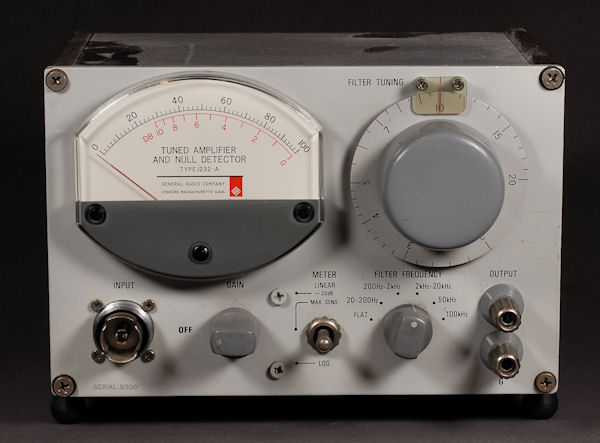

The 1232-A is the preferred detector for almost all the GR bridges. It's continuously tunable from 20 Hz to 20 kHz, and has fixed settings of 50 and 100 kHz. The sensitivity is less than a microvolt over most of the range and can be set to linear or log. You'll find examples in deep gray crackle finish, deep gray plain finish and the more modern light plain finish with silkscreened lettering rather than engraving, as shown above. There seems to be no performance difference between any of them.
The circuitry is a bit convoluted if you're not used to discrete amplifiers, but generally trouble free. Signals can be traced in the usual manner, and the most likely troublemakers are aluminum electrolytic capacitors and previous troubleshooters! I strongly recommend replacing only components that are actually proven defective by measurement. GR used excellent quality parts and wholesale replacement for no reason just tears up the circuit boards and accomplishes little except creating a non-original instrument.
The 1232-A was designed to use 9 M72 (Mallory RM-4R) mercury batteries. Since these are no longer available, another 12 VDC power source is needed. This should be floating and completely isolated, otherwise stray capacitance and leakage may create a path back to the signal generator, paralleling a bridge arm and leading to errors in the bridge balance.
Since we are just temporary caretakers of this classic equipment, I don't feel any irreversible modifications should be made. I will not drill holes or cut metal. As luck would have it, there's a hole on the left side of the instrument that was placed for side-by-side mounting of two half-rack instruments. This hole is just the right size for a panel mount RCA jack.
With easy access to the inside of the instrument, you now have several choices. The easiest is simply to wire power to the jack and use an external battery pack. Charging is up to you. This is in fact the method I use with my 1615-A bridge assembly, as the 1232-A is mounted side-by-side with the signal generator.
In this case I wanted the instrument to work and look as close to original as possible, so I chose a slightly more difficult path. 10 NiCad button cells were joined in series and made mechanically sound with a large piece of shrink tubing. these were wrapped in a thin layer of foam and slipped into the original battery compartment. Connections were made to the bus wire coming off the original battery contact and to the RCA jack ground. A current limit resistor of 402 ohms was wired to the RCA jack, providing a convenient means of charging. I use a 12V "wall wart" for this, as the open circuit voltage is several volts higher. The 1232-A will work while charging, but for critical measurements, it should be used completely floating. I've used this NiCad power method for several years with no hitches whatsoever.
C. Hoffman
last edit October 12, 2011